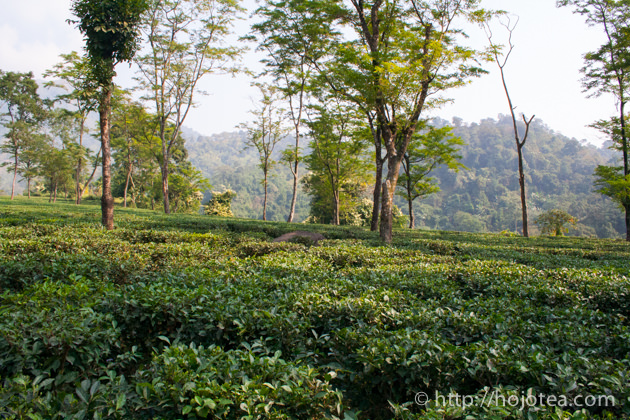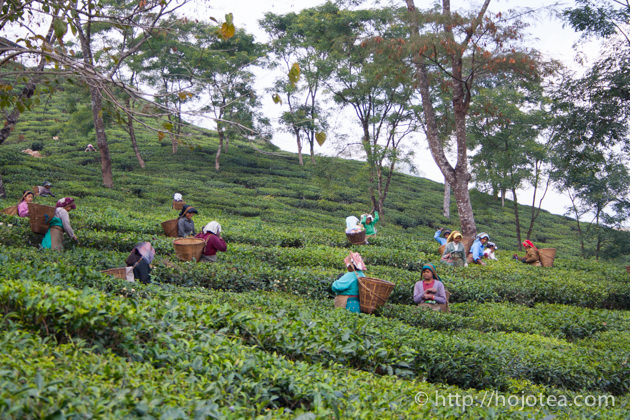- HOME >
- Tea Column
Easy way to understand the scientific name of tea
- [2015.01.15] Posted By Akira Hojo

Tea is made of the plant called Camellia sinensis. But as you know, it is further classified into various types such as Assam, Yabukita, Tie Guan Yin, Shui Xian or China bush. Are these types considered as species or cultivar? I would like to explain the rules that classify the type of tea variety.
There is cultivar and variety under the species
In precise, tea plant is classified as follow. Regardless of oolong, green, pu-erh, black or white tea, the tea is basically made from the leaves of a plant called Camellia sinensis.
Family (科) Theaceae
Genus(属) Camellia
Species (種) Sinensis
Camellia sinensis means that genus is Camellia and the species is sinensis. Under the sinensis species, there are 2 types of sub-species: variety and cultivar. If you refer to the sub-species in both Chinese and Japanese, there will be some confusion. It is because of there is no distinction in both Chinese and Japanese language to differentiate between cultivar and variety. We only use one word “pin-zhong”「品種」 to describe both cultivar and variety.
Variety refers to the group that carries the homogenous genetic trait made by the natural selection of mutation
In botanical terminology, variety refers to the sub-species that a group of plants carry a single genetic trait on account of natural selection or mutation. Despite the plant is propagating by its own, every individual plant carries their own single characteristics. For example, the tea discovered in Assam area in India all have big leaves, higher poly phenol content and adapting to grow in tropical climate. If only one of the tea trees carries these characteristics, we do not call it variety, but all the trees has the same trait. In botanical terminology, the Assam tea is written as Camellia sinensis var. assamica. The variety is usually written as var. in the shorten form. The name Camellia sinensis var. assamica tells that this tea was naturally evolved and it does not involves any human’s efforts.
Cultivar refers to the tea made by the human’s selection
While the variety means homogenous characteristics made by the natural selection, the cultivar refers to a specific type of tea made by the cultivation by the human. For example, Tie Guan Yin cultivar, Shui Xian cultivar or Yabukita cultivar; these are a few examples of tea cultivars always been propagated by cloning. Thus, it is not called variety but cultivar. The tea tree produces seeds through sexual reproduction. That means the stamen and pistil of tea flower has to undergo crossbreeding in order to produce its seed. Usually if you plant a seed from Yabukita cultivar, the tea tree grown from this seed is not Yabukita cultivar. It will be something else as seed is made of the natural hybridization. The same theory goes with the fruit. Even if we plant the seed of Fuji apple, there will be another type of apple that grows from the seed. That is why once an ideal genetic trait is being found, the plant is propagated by the cutting (cloning). The plan that is propagated with cloning is categorized as “cultivar” in scientific term. It is written in the shorten form cv. or with single quotation as ‘Yabukita’.
After all, the scientific name of Yabukita will be as follow.
Camellia sinensis var. sinensis cv. Yabukita
Camellia sinensis var. sinensis ‘Yabukita’
What is Camellia sinensis var. sinensis?
In the above name of Yabukita, sinensis is repeated twice. You may wonder what the meaning of Camellia sinensis var. sinensis is. Camellia sinensis var. sinensis is referring to the group of tea that has originated from China. Since the first tea was found in China and these teas had small leaves, it was classified as variety. In Darjeeling, there are so-called China bush. These tea bushes were imported from China once upon a time. So the scientific name of these China bush in Darjeeling is also Camellia sinensis var. sinensis
Unclear scientific name of Darjeeling clonal tea
Nowadays, there are a number of tea cultivars modified from Assam variety. These cultivars are mainly used for making black tea. Since these tea plants were made from the Camellia Sinensis var. assamica by the crossbreeding, the name will be written as Camellia sinensis var. assamica cv. xxxxx. That means this is the tea cultivated by human using Camellia sinensis var. assamica. In Darjeeling, there are tea bushes called clonal. The Darjeeling clonal is referring to the tea propagated by cloning. That means it is the tea categorized as cultivar. However, most of them were crossbred between Assam Tea (Camellia sinensis var. assamica) and China tea (Camellia sinensis var. sinensis). I cannot imagine how the scientific name for these clonal teas are since it will be too long and complicated. That is why no one called Darjeeling clonal tea in the name of cultivar but just as a clonal tea.
Many prejudices with China variety
England has started the tea trading with China in 17th century. In those days, the crossbreeding has been already effectively practiced in China. For example, there are Phoenix cultivars such as Shui Xian, Ba Xian or Song Zhong which the age of tea trees are more than 500 years old. In 17th-19th century, English noticed that Chinese tea leaves were small and round shape and they concluded as “variety”. However, it is very likely that these teas they saw could have been the tea that was made by the hybridization. Considering the fact English were buying tea from Fujian province, they might saw the Shui Xian related cultivar and named them as China variety: Camellia sinensis var. sinensis. As a matter of fact, there are various sizes of tea leaves in China: small, medium and large. Somehow calling the Chinese tea as China variety: Camellia sinensis var. sinensis has a lot of prejudices.
Related Articles
How to get the latest update on HOJO?
1. Follow Twitter, 2. Click "Like" on Facebook, and 3. Subscribe in newsletter. You can have the latest tea news from HOJO.
 Subscribe the Newsletter to enjoy the privileges
Subscribe the Newsletter to enjoy the privileges- You may receive a free sample upon purchase, or you may have the priority to purchase special products. So please remember to subscribe our newsletter as well as the social network.
- Myanmar White Tea Bud 2013 from Guo Gan, Myanmar
- We have released a raw Pu-erh tea, 緬甸白芽茶 2013 (Myanmar White Tea Bud 2013), produced by ethnic minorities in t …
- Yong De Wild White Tea 2025 Loose Leaf Limited Release
- We have released Yong De Wild White Tea Loose 2025. For the 2025 harvest, only the loose-leaf type was …
NEW ARTICLES
 Myanmar White Tea Bud 2013 from Guo Gan, Myanmar
Myanmar White Tea Bud 2013 from Guo Gan, Myanmar- We have released a raw Pu-erh tea, 緬甸白芽茶 2013 (Myanmar White Tea Bud 2013), produced by ethnic minorities in t …
 Yong De Wild White Tea 2025 Loose Leaf Limited Release
Yong De Wild White Tea 2025 Loose Leaf Limited Release- We have released Yong De Wild White Tea Loose 2025. For the 2025 harvest, only the loose-leaf type was …
 Experience the True Freshness of Raw Pu-erh : Tang Jia 2025 Loose Leaf Release
Experience the True Freshness of Raw Pu-erh : Tang Jia 2025 Loose Leaf Release- We have released Tang Jia Raw Pu-erh Tea 唐家古樹生茶 2025 Loose Leaf. Among HOJO’s raw pu-erh teas, Tang Jia Raw Pu …
 Yunnan Chun Jian Green Tea from High Mountain Gardens
Yunnan Chun Jian Green Tea from High Mountain Gardens- Yunnan Chun Jian Green Tea is now available. This tea is made from naturally grown leaves harvested from high …
 Limited Loose Leaf Release of 2025 Da Xue Shan Wild Raw Pu-erh Tea
Limited Loose Leaf Release of 2025 Da Xue Shan Wild Raw Pu-erh Tea- We have released the 2025 loose-leaf version of Da Xue Shan Wild Raw Pu-erh Tea. This tea comes from wild tea …
 Discover a New Way to Enjoy Tea: Cooking Rice with Tea
Discover a New Way to Enjoy Tea: Cooking Rice with Tea- Cooking rice with tea is a simple idea, but it brings surprisingly satisfying results. The tea’s flavour seeps …
 2025 Da Xue Shan Wild White Tea Now Available from Yunnan
2025 Da Xue Shan Wild White Tea Now Available from Yunnan- The 2025 harvest of Da Xue Shan Wild White Tea is now available. Crafted from truly wild Camellia taliensis tr …
 Fresh 2025 Yunnan White Tea – Select Your Favourite Lot Before Blending
Fresh 2025 Yunnan White Tea – Select Your Favourite Lot Before Blending- Freshly crafted in Yunnan and just arrived in KL, our new 2025 white tea is now available at our Gardens Mall …
 2024 Dong Shan Raw Pu-erh Tea – Crafted with the Producer for Desired Quality
2024 Dong Shan Raw Pu-erh Tea – Crafted with the Producer for Desired Quality- We have released the 2024 cake of Dong Shan Raw Pu-erh Tea. Earlier, we offered the loose-leaf version from th …
 Development of Firewood Roasted Hojicha Using Naturally Grown Tea from Yunnan
Development of Firewood Roasted Hojicha Using Naturally Grown Tea from Yunnan- We are currently staying in Yunnan Province for tea production. As the season nears its end, tea trees with pa …
Category
- New Arrival at HOJO Online Shop
- Featured Articles
- Newsletter
- Types of Tea
- Origin of Tea
- Teapot and Tea Equipment
-
Tea Column
- How to enjoy tea
- Tea Processing
- How to choose quality tea
- Tea constituents and functional effect
- Safety of Tea
- Foods
- Tea Business Operation
- Hobby and Outdoor Activity
- Ranking of Tea
- Video
- FAQ
- Media Release
Profile

- AKIRA HOJO
- I invite you to experience my tea selections.I was born in Nagano, Japan. In university, I studied agricultural chemistry, and I have the master degree in food science. I worked in Japanese food industry for 10 years. I involved in R&D, QC and QA. As a factory manager, I implemented ISO9000 series and managed the factory.
- The Art of Tea Magazine
- We posted the article on “The Art of Tea Magazine No.9, the magazine is published in Taiwan. We featured …
- New Straits Times
- The Malaysian National Newspaper, New Straits Times featured HOJO Tea on 17-Oct-2007.
Shop Info

Address:Lot No. T-215, 3rd Floor, The Gardens Mall, Mid Valley City, Lingkaran Syed Putra, 59200 Kuala Lumpur
Tel: +603-2287-4537
Business Hour: 10am to 10pm
















